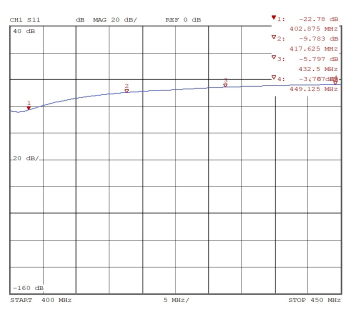The S-parameter describes an electrical network's behavior, which is important for the matching
process. For a standard matching from a known complex impedance to a target value, the
S11 consideration is suitable. The S11, also called the
reflection coefficient, describes the amount of energy that is reflected from a network.
The result, also called return loss, is the direct indicator for the quality of the
circuit's performance. A network with an S11 = 0 dB does not transfer
anything and reflects 100% of the injected energy. The ideal case is a matching network
with an S11 = -10 dB. That means 90% of the injected energy is passed through
the network and only 10% gets lost via reflection. The following figure shows an example
for an S11 plot. This plot is linked to the Smith Chart shown in Figure 1.

Figure 1. S11 with Frequency
Sweep

The matching used in this example is excellent for the frequency shown at marker 1 as >99% of the energy is used and transferred through the network. The other frequencies are not matched to the target impedance. The performance at the frequency at marker 4 is not acceptable as only 58% of the energy is used for the transmission through the network. This method shows the lower the number, the better the performance and the better the selected matching identified with the Smith Chart.